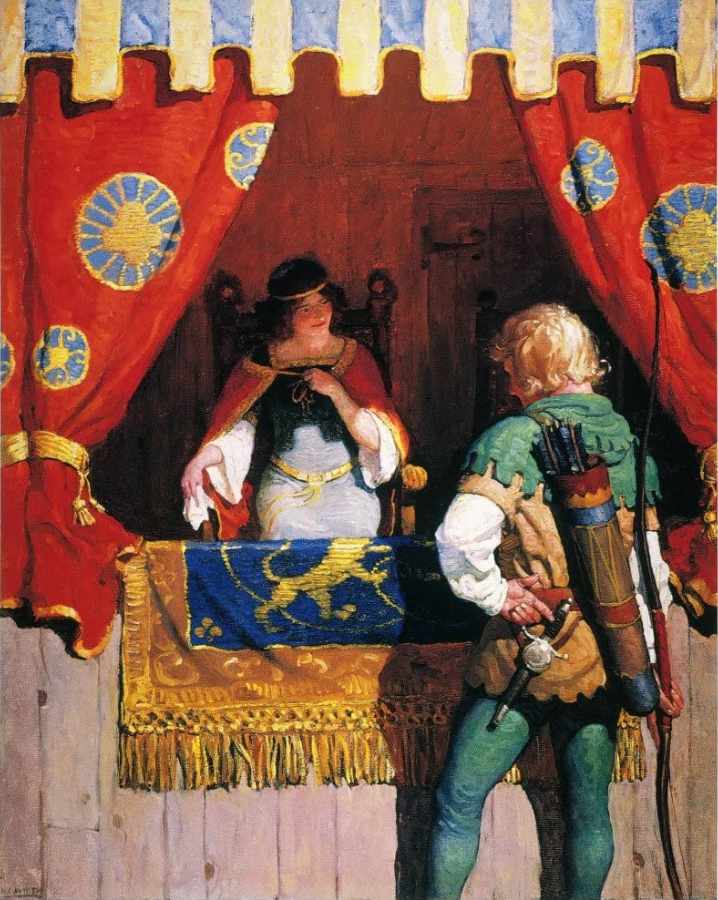Maid Marian is the heroine of the Robin Hood legend in English folklore, often taken to be his lover. She is not mentioned in the early, medieval versions of the legend, but was the subject of at least two plays by 1600. Her history and circumstances are obscure, but she commanded high respect in Robin’s circle for her courage and independence as well as her beauty and loyalty. For this reason, she is celebrated by feminist commentators as one of the early strong female characters in English literature. In Robin Hood and Maid Marian (Child Ballad 150, perhaps dating to the 17th century), Maid Marian is “a bonny fine maid of a noble degree” said to excel both Helen and Jane Shore in beauty. Separated from her lover, she dresses as a page “and ranged the wood to find Robin Hood,” who was himself disguised, so that the two begin to fight when they meet. As is often the case in these ballads, Robin Hood loses the fight to comical effect, and Marian only recognizes him when he asks for quarter. This ballad is in the “Earl of Huntington” tradition, a supposed “historical identity” of Robin Hood forwarded in the late 16th century.
| Alias Maid Marian |
| Real Names/Alt Names Marian |
| Characteristics Hero, Outlaw Hero, Robin Hood Universe, Medieval Age, British |
| Creators/Key Contributors N. C. Wyeth, Unknown |
| First Appearance English folklore |
| First Publisher ○ |
| Appearance List Ballads: A Gest of Robyn Hode, Robin Hood and the Monk, Robin Hood and the Curtal Friar, Robin Hood and Allin a Dalem, Robin Hood and Queen Catherin, Robin Hood and the Golden Arrow, Robin Hood and the Tanner of Blyth. Literature: The Merry Adventures of Robin Hood by Howard Pyle (1883, PG), Robin Hood by Paul Creswick (PG), Robin Hood by Anonymous (PG), Bold Robin Hood-And His Outlaw Band by Louis Rhead (1912, Internet Archive), Robin Hood and the Men of the Greenwood (1920) [Internet Archive], Robin Hood: His Deeds and Adventures as Recounted in the Old English Ballads (1923) [Internet Archive]. Comics: Arrow #2, Green Hornet Comics #7-10, Tales of Robin Hood #1-6, Hit Comics #26, 51, Kid Eternity #2, Smash Comics #27, Jumbo Comics #67, Cat-Man Comics #26, Robin Hood and Company Comics vol. 3 #32-34, Robin Hood and His Merry Men #28-38, Robin Hood #1-5, Young Heroes #35-37, The Adventures of Robin Hood #1-8 (reprint), Robin Hood 1-2, 9-10, 15 (reprint), Treasure Chest of Fun & Facts vol. 3 #14-17, Boy Comics #3-32, Buster Brown #3, 9, Thriller Comics Library #4, 27, 29, 80, 91, 106, 114, 118, 122, 126, 130, 134, 138, 142, 154, 162, 186, 202, 214, 218. Film: At least five silent shorts from 1908-1913, Robin Hood (1922), The Adventures of Robin Hood (1938), The Bandit of Sherwood Forest (1946), The Prince of Thieves (1948), Rogues of Sherwood Forest (1950), Tales of Robin Hood (1951), et. al. TV: The Adventures of Robin Hood (1956, 143 episodes). |
| Sample Read The Merry Adventures of Robin Hood [PG] |
| Description Maid Marian is the heroine of the Robin Hood legend in English folklore, often taken to be his lover. She is not mentioned in the early, medieval versions of the legend, but was the subject of at least two plays by 1600. Her history and circumstances are obscure, but she commanded high respect in Robin’s circle for her courage and independence as well as her beauty and loyalty. For this reason, she is celebrated by feminist commentators as one of the early strong female characters in English literature. In Robin Hood and Maid Marian (Child Ballad 150, perhaps dating to the 17th century), Maid Marian is “a bonny fine maid of a noble degree” said to excel both Helen and Jane Shore in beauty. Separated from her lover, she dresses as a page “and ranged the wood to find Robin Hood,” who was himself disguised, so that the two begin to fight when they meet. As is often the case in these ballads, Robin Hood loses the fight to comical effect, and Marian only recognizes him when he asks for quarter. This ballad is in the “Earl of Huntington” tradition, a supposed “historical identity” of Robin Hood forwarded in the late 16th century. |
| Source Maid Marian – Wikipedia |

